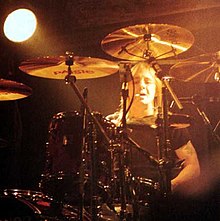
AC/DC are an Australian rock band formed in 1973. They were founded by brothers Malcolm Young on rhythm guitar and Angus Young on lead guitar. Their current lineup comprises Angus, bassist Cliff Williams, drummer Phil Rudd, lead vocalist Brian Johnson, and rhythm guitarist Stevie Young, nephew of Angus and Malcolm. Their music has been variously described as hard rock, blues rock and heavy metal, but the band calls it simply "rock and roll". They are cited as a formative influence on the new wave of British heavy metal bands, such as Def Leppard and Saxon. AC/DC were inducted into the Rock and Roll Hall of Fame in 2003.

Back in Black is the seventh studio album by Australian rock band AC/DC, released by Albert Productions and Atlantic Records on 25 July 1980. It was the band's first album to feature Brian Johnson as lead singer, following the death of Bon Scott, their previous vocalist.

Highway to Hell is the sixth studio album by Australian hard rock band AC/DC, released on 27 July 1979. It is the first of three albums produced by Robert John "Mutt" Lange, and is the last album featuring lead singer Bon Scott, who died on 19 February 1980.
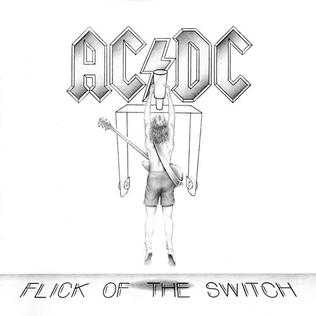
Flick of the Switch is the ninth studio album by Australian hard rock band AC/DC. The album was deemed a commercial disappointment after it failed to match the sales figures of the band's two previous releases, 1980's Back in Black and 1981's For Those About to Rock, and its release represented the beginning of the band's commercial decline. The third AC/DC album to feature lead vocalist Brian Johnson, the album is also the last to feature drummer Phil Rudd before his return on Ballbreaker (1995). The album was re-released in 2003 as part of the AC/DC Remasters series.
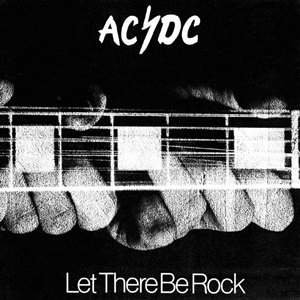
Let There Be Rock is the fourth studio album by Australian rock band, AC/DC. It was originally released on 21 March 1977 in Australasia, through Albert Productions label. A modified international edition was released on 25 July 1977, through Atlantic Records. It was the last AC/DC album to feature Mark Evans on bass.

T.N.T. is the second studio album by Australian hard rock band AC/DC, released only in Australia on 1 December 1975. This was the band's first release with bassist Mark Evans and drummer Phil Rudd, although the last two tracks feature George Young and Tony Currenti, both of whom previously appeared on High Voltage.

Powerage is the fifth studio album by Australian hard rock band AC/DC, released in 1978. This was the band's first album to feature Cliff Williams on bass guitar, and it was also the first AC/DC album not to have a title track and the first worldwide not to be released with a different album cover. Powerage was re-released in 2003 as part of the AC/DC Remasters series.

The Razors Edge is the twelfth studio album by Australian rock band AC/DC. Released on 24 September 1990, through Albert Productions/CBS Records International in Australasia and Atlantic Records in Europe, it was recorded in 1990 in Little Mountain Sound Studios in Vancouver, Canada, and was mixed and engineered by Mike Fraser and produced by Bruce Fairbairn. It was a major comeback for the band, featuring the hits "Thunderstruck", "Are You Ready" and "Moneytalks". This is the only studio album to feature Welsh drummer Chris Slade, who was the drummer for AC/DC from 1989 to his dismissal in 1994.
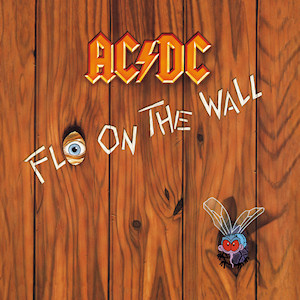
Fly on the Wall is the tenth studio album by Australian hard rock band AC/DC, released on 28 June 1985 by Albert Productions, and Atlantic Records. The album was re-released in 2003 as part of the AC/DC Remasters series.
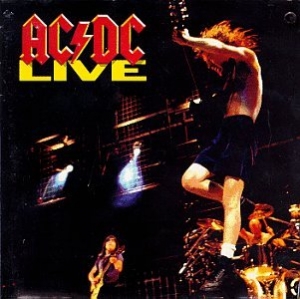
AC/DC Live is the second live album by Australian hard rock band AC/DC, released in October 1992. Two versions were released, one containing a single CD, with the second version being a double album on LP and CD known as AC/DC Live: 2 CD Collector's Edition. A feature-length live video, AC/DC: Live at Donington, was released concurrently. The double album AC/DC Live: 2 CD Collector's Edition was released a month after the single-disc version, in a slipcased two-disc "book" and containing an AC/DC dollar note known as "Angus Bucks". Both editions of the album were re-released in 2003 as part of the AC/DC Remasters series.

Australian rock band AC/DC have released 18 studio albums, two soundtrack albums, three live albums, one extended play, 57 singles, 11 video albums, 52 music videos and two box sets. Although many AC/DC singles have been released, the band refused to issue any greatest hits albums. Who Made Who, which served as the soundtrack to Stephen King's film Maximum Overdrive, Iron Man 2 and the band's various live recordings are the closest they have issued to such a compilation.

Dirty Deeds Done Dirt Cheap is the third studio album by Australian hard rock band AC/DC, originally released only in Europe, Australia and New Zealand in 1976. The album was not released in the United States until 1981, more than one year after lead singer Bon Scott's death. This was also AC/DC's first album in its entirety to be recorded with the same lineup, rather than including at least one track recorded with a different bassist or drummer.

Black Ice is the fifteenth studio album by Australian rock band AC/DC. First released in Europe on 17 October 2008 and released internationally on 20 October 2008, it was produced by Brendan O'Brien. It marked the band's first original recordings since Stiff Upper Lip (2000), with the eight-year gap being the longest between AC/DC's successive studio albums. Black Ice has the longest running time of any AC/DC studio album. The album was the band's final studio release to feature founding rhythm guitarist Malcolm Young, who left the band in September 2014 after being diagnosed with dementia, and died three years later.

For Those About to Rock (We Salute You) (shortened to For Those About to Rock on its cover) is the eighth studio album by Australian hard rock band AC/DC. It was released on 20 November 1981 in the United States, 23 November 1981 in the United Kingdom and 7 December 1981 in Australia.
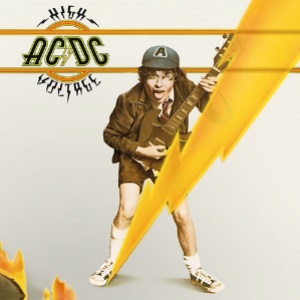
High Voltage is the first internationally released album by Australian hard rock band AC/DC. It contains tracks completed from their first two previous Australia-only issued albums, High Voltage and T.N.T..
Iron Man 2 is a soundtrack album for the 2010 film of the same name consisting of music by Australian hard rock band AC/DC. It was released on April 19, 2010.
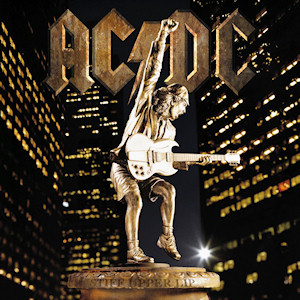
Stiff Upper Lip is the 14th studio album by Australian hard rock band AC/DC. It was released on 28 February 2000. The album was produced by George Young, older brother of Malcolm and Angus Young. It was the last AC/DC album that George produced before his death in 2017.

Live at River Plate is a live album by Australian hard rock band AC/DC, released on 19 November 2012.

Rock or Bust is the sixteenth studio album by Australian rock band AC/DC, released on 28 November 2014. Rock or Bust is the group's first album to feature rhythm guitarist Stevie Young, replacing founding member Malcolm Young, who had retired from the band earlier in the year due to health concerns. It is the shortest studio album ever released by the band. At approximately 35 minutes, it is two minutes shorter than their previous shortest album, Flick of the Switch, which was released in 1983. It sold 2.8 million copies worldwide.

Power Up is the seventeenth studio album by Australian rock band AC/DC, released on 13 November 2020 through Columbia Records. Power Up marks the return of vocalist Brian Johnson, drummer Phil Rudd and bassist Cliff Williams, all of whom left AC/DC before, during, and after the supporting tour for their previous album Rock or Bust (2014). This is also the band's first album since the death of co-founder and rhythm guitarist Malcolm Young in 2017 and it serves as a tribute to him, according to his brother Angus; Malcolm received posthumous songwriting credits for all of the album's songs, as they were never-before released tracks written by both brothers. Power Up was generally well received by music critics and reached number one in 21 countries. The album was nominated for the Best Rock Album on the 64th Annual Grammy Awards, but lost to Foo Fighters' Medicine at Midnight (2021). It sold 1.4 million copies worldwide.

